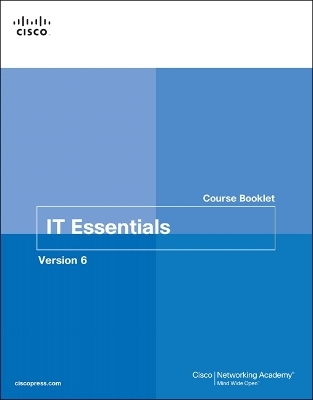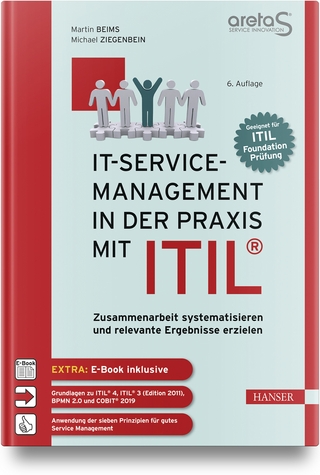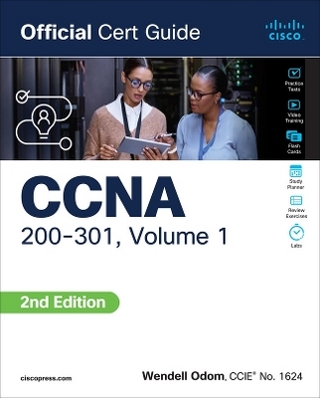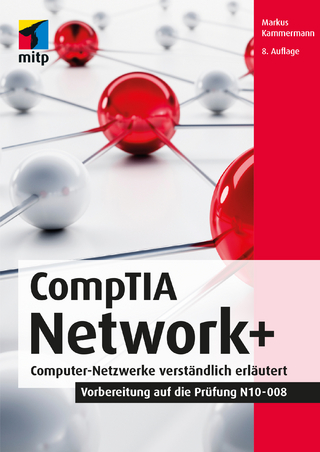
IT Essentials Course Booklet, Version 6
Cisco Press (Verlag)
978-1-58713-356-5 (ISBN)
IT Essentials Course Booklet, Version 6
Your Cisco Networking Academy Course Booklet is designed as a study resource you can easily read, highlight, and review on the go, wherever the Internet is not available or practical:
· The text is extracted directly, word-for-word, from the online course so you can highlight important points and take notes in the "Your Chapter
· Notes" section.
· Headings with the exact page correlations provide a quick reference to the online course for your classroom discussions and exam preparation.
· An icon system directs you to the online curriculum to take full advantage of the images embedded within the Networking Academy online course interface and reminds you to do the labs, interactive activities, packet tracer activities, watch videos, and take the chapter quizzes.
The Course Bookletis a basic, economical paper-based resource to help you succeed with the Cisco Networking Academy online course.
Cisco Networking Academy teaches hundreds of thousands of students annually the skills needed to build, design, and maintain networks, improving their career prospects while filling the global demand for networking professionals. With 10,000 academies in 165 countries, it helps individuals prepare for industry-recognized certifications and entry-level information and communication technology careers in virtually every industry–developing foundational technical skills while acquiring vital 21st-century career skills in problem solving, collaboration, and critical thinking. Cisco Networking Academy uses a public-private partnership model to create the "world's largest classroom."
Chapter 0 Course Introduction 1
0.0 Welcome to IT Essentials 1
0.0.1 Message to the Student 1
0.0.2 The IT Industry 2
Chapter 1 Introduction to the Personal Computer System 7
1.0 Introduction 7
1.1 Personal Computer Systems 7
1.1.1 Cases and Power Supplies 7
1.1.2 Internal PC Components 10
1.1.3 External Ports and Cables 17
1.1.4 Input and Output Devices 20
1.2 Select Computer Components 23
1.2.1 Select PC Components 23
1.3 Configurations for Specialized Computer Systems 29
1.3.1 Specialized Computer Systems 29
1.4 Chapter Summary 34
Chapter 2 Introduction to Lab Procedures and Tool Use 37
2.0 Introduction 37
2.1 Safe Lab Procedures 37
2.1.1 Procedures to Protect People 37
2.1.2 Procedures to Protect Equipment and Data 39
2.1.3 Procedures to Protect the Environment 41
2.2 Proper Use of Tools 43
2.2.1 Hardware Tools 43
2.2.2 Software Tools 44
2.2.3 Organizational Tools 45
2.2.4 Demonstrate Proper Tool Use 46
2.3 Summary 50
Chapter 3 Computer Assembly 53
3.0 Introduction 53
3.1 Assemble the Computer 53
3.1.1 Open the Case and Connect the Power Supply 53
3.1.2 Install the Motherboard 54
3.1.3 Install Drives 57
3.1.4 Install the Adapter Cards 58
3.1.5 Install Cables 59
3.2 Boot the Computer 64
3.2.1 POST, BIOS, UEFI 64
3.2.2 BIOS and UEFI Configuration 66
3.3 Upgrade and Configure a Computer 70
3.3.1 Motherboard and Related Components 70
3.3.2 Storage Devices 73
3.3.3 Peripheral Devices 74
3.4 Chapter Summary 75
Chapter 4 Overview of Preventive Maintenance 77
4.0 Introduction 77
4.1 Preventive Maintenance 77
4.1.1 PC Preventive Maintenance Overview 77
4.2 Troubleshooting Process 81
4.2.1 Troubleshooting Process Steps 81
4.2.2 Common Problems and Solutions 85
4.3 Chapter Summary 85
Chapter 5 Windows Installation 89
5.0 Introduction 89
5.1 Modern Operating Systems 89
5.1.1 Operating System Terms and Characteristics 89
5.1.2 Types of Operating Systems 91
5.1.3 Customer Requirements for an Operating System 92
5.1.4 Operating Systems Upgrade 94
5.2 Operating System Installation 96
5.2.1 Storage Device Setup Procedures 96
5.2.2 Custom Installation Options 104
5.2.3 Boot Sequence and Registry Files 108
5.2.4 Mulitiboot 110
5.2.5 Disk Directories 114
5.3 Summary 117
Chapter 6 Windows Configuration and Management 119
6.0 Introduction 119
6.1 The Windows GUI and Control Panel 119
6.1.1 Windows Desktop, Tools and Applications 119
6.1.2 Control Panel Utilities 125
6.1.3 Administrative Tools 135
6.1.4 Disk Defragmenter and Disk Error-Checking Tool 138
6.1.5 Command Line Tools 140
6.2 Client-Side Virtualization 142
6.2.1 Purpose and Requirements of Virtualization 142
6.3 Common Preventive Maintenance Techniques for Operating Systems 144
6.3.1 OS Preventive Maintenance Plan 144
6.4 Basic Troubleshooting Process for Operating Systems 148
6.4.1 Applying the Troubleshooting Process for Operating Systems 148
6.4.2 Common Problems and Solutions for Operating Systems 149
6.5 Chapter Summary 149
Chapter 7 Networking Concepts 151
7.0 Introduction 151
7.1 Principles of Networking 151
7.1.1 Computer Networks 151
7.1.2 Types of Networks 154
7.2 Networking Standards 156
7.2.1 Reference Models 156
7.2.2 Wired and Wireless Ethernet Standards 158
7.3 Physical Components of a Network 160
7.3.1 Network Devices 160
7.3.2 Cables and Connectors 163
7.4 Basic Networking Concepts and Technologies 166
7.4.1 Networked Equipment Addressing 166
7.4.2 Transport Layer Protocols 171
7.5 Chapter Summary 173
Chapter 8 Applied Networking 175
8.0 Introduction 175
8.1 Computer to Network Connection 175
8.1.1 Networking Cards 175
8.1.2 Wireless and Wired Router Configurations 178
8.1.3 Network Sharing 184
8.1.4 Remote Connections 188
8.2 ISP Connection Technologies 190
8.2.1 Broadband Technologies 190
8.3 Internet Technologies 194
8.3.1 Data Centers and Cloud Computing 194
8.3.2 Networked Host Services 196
8.4 Common Preventive Maintenance Techniques Used for Networks 199
8.4.1 Network Maintenance 199
8.5 Basic Troubleshooting Process for Networks 200
8.5.1 Applying the Troubleshooting Process to Networks 200
8.5.2 Common Problems and Solutions for Networks 201
8.6 Chapter Summary 201
Chapter 9 Laptops and Mobile Devices 203
9.0 Introduction 203
9.1 Laptop Components 203
9.1.1 Features of Laptop Components 203
9.1.2 Laptop Displays 207
9.2 Laptop Configuration 208
9.2.1 Power Settings Configuration 208
9.2.2 Wireless Configuration 210
9.3 Laptop Hardware and Component Installation and Configuration 212
9.3.1 Expansion Slots 212
9.3.2 Replacing Hardware Devices 215
9.4 Mobile Device Hardware Overview 223
9.4.1 Mobile Device Hardware 223
9.4.2 Other Mobile Devices 227
9.5 Common Preventive Maintenance Techniques for Laptops and Mobile Devices 229
9.5.1 Scheduled Maintenance for Laptops and Mobile Devices 229
9.6 Basic Troubleshooting Process for Laptops and Mobile Devices 231
9.6.1 Applying 231
9.6.2 Common Problems and Solutions for Laptops and Mobile Devices 232
9.7 Chapter Summary 232
Chapter 10 Mobile, Linux, and OS X Operating Systems 235
10.0 Introduction 235
10.1 Mobile Operating Systems 235
10.1.1 Android vs. iOS 235
10.1.2 Android Touch Interface 238
10.1.3 iOS Touch Interface 241
10.1.4 Windows Phone Touch Interface 244
10.1.5 Common Mobile Device Features 245
10.2 Methods for Securing Mobile Devices 250
10.2.1 Passcode Locks 250
10.2.2 Cloud-Enabled Services for Mobile Devices 253
10.2.3 Software Security 255
10.3 Network Connectivity and Email 257
10.3.1 Wireless and Cellular Data Network 257
10.3.2 Bluetooth 260
10.3.3 Configuring Email 262
10.3.4 Mobile Device Synchronization 265
10.4 Linux and OS X Operating Systems 268
10.4.1 Linux and OS X Tools and Features 268
10.4.2 Linux and OS X Best Practices 272
10.4.3 Basic CLI 274
10.5 Basic Troubleshooting Process for Mobile, Linux, and OS X Operating Systems 276
10.5.1 Applying the Troubleshooting Process to Mobile, Linux, and OS X Operating Systems 276
10.5.2 Common Problems and Solutions for Mobile, Linux, and OS X Operating Systems 277
10.6 Chapter Summary 278
Chapter 11 Printers 281
11.0 Introduction 281
11.1 Common Printer Features 281
11.1.1 Characteristics and Capabilities 281
11.1.2 Printer Types 283
11.2 Installing and Configuring Printers 287
11.2.1 Installing and Updating a Printer 287
11.2.2 Configuring Options and Default Settings 290
11.2.3 Optimizing Printer Performance 292
11.3 Sharing Printers 293
11.3.1 Operating System Settings for Sharing Printers 293
11.3.2 Print Servers 295
11.4 Maintaining and Troubleshooting Printers 297
11.4.1 Printer Preventive Maintenance 297
11.4.2 Troubleshooting Printer Issues 299
11.4.3 Common Problems and Solutions for Printers 300
11.5 Chapter Summary 300
Chapter 12 Security 303
12.0 Introduction 303
12.1 Security Threats 303
12.1.1 Types of Security Threats 303
12.2 Security Procedures 307
12.2.1 Windows Local Security Policy 307
12.2.2 Securing Web Access 309
12.2.3 Protecting Data 312
12.2.4 Protection Against Malicious Software 317
12.2.5 Security Techniques 319
12.2.6 Protecting Physical Equipment 323
12.3 Common Preventive Maintenance Techniques for Security 326
12.3.1 Security Maintenance 326
12.4 Basic Troubleshooting Process for Security 331
12.4.1 Applying the Troubleshooting Process to Security 331
12.4.2 Common Problems and Solutions for Security 332
12.5 Summary 333
Chapter 13 The IT Professional 335
13.0 Introduction 335
13.1 Communication Skills and the IT Professional 335
13.1.1 Communication Skills, Troubleshooting and the IT Professional 335
13.1.2 Working with a Customer 336
13.1.3 Employee Best Practices 339
13.2 Ethical and Legal Issues in the IT Industry 341
13.2.1 Ethical and Legal Considerations 341
13.2.2 Legal Procedures Overview 344
13.3 Call Center Technicians 347
13.3.1 Call Centers, Level One Technicians, and Level Two Technicians 347
13.4 Chapter Summary 348
Chapter 14 Advanced Troubleshooting 351
14.0 Introduction 351
14.1 Computer Components and Peripherals 351
14.1.1 Apply Troubleshooting Process to Computer Components and Peripherals 351
14.2 Operating Systems 352
14.2.1 Apply Troubleshooting Process to Operating Systems 352
14.3 Networks 352
14.3.1 Apply Troubleshooting Process to Networks 352
14.4 Security 353
14.4.1 Apply Troubleshooting Process to Security 353
14.5 Chapter Summary 354
9781587133565 TOC 4/22/2016
| Erscheinungsdatum | 10.06.2016 |
|---|---|
| Reihe/Serie | Course Booklets |
| Verlagsort | Indianapolis |
| Sprache | englisch |
| Maße | 220 x 275 mm |
| Gewicht | 860 g |
| Themenwelt | Informatik ► Weitere Themen ► Zertifizierung |
| ISBN-10 | 1-58713-356-3 / 1587133563 |
| ISBN-13 | 978-1-58713-356-5 / 9781587133565 |
| Zustand | Neuware |
| Haben Sie eine Frage zum Produkt? |
aus dem Bereich


